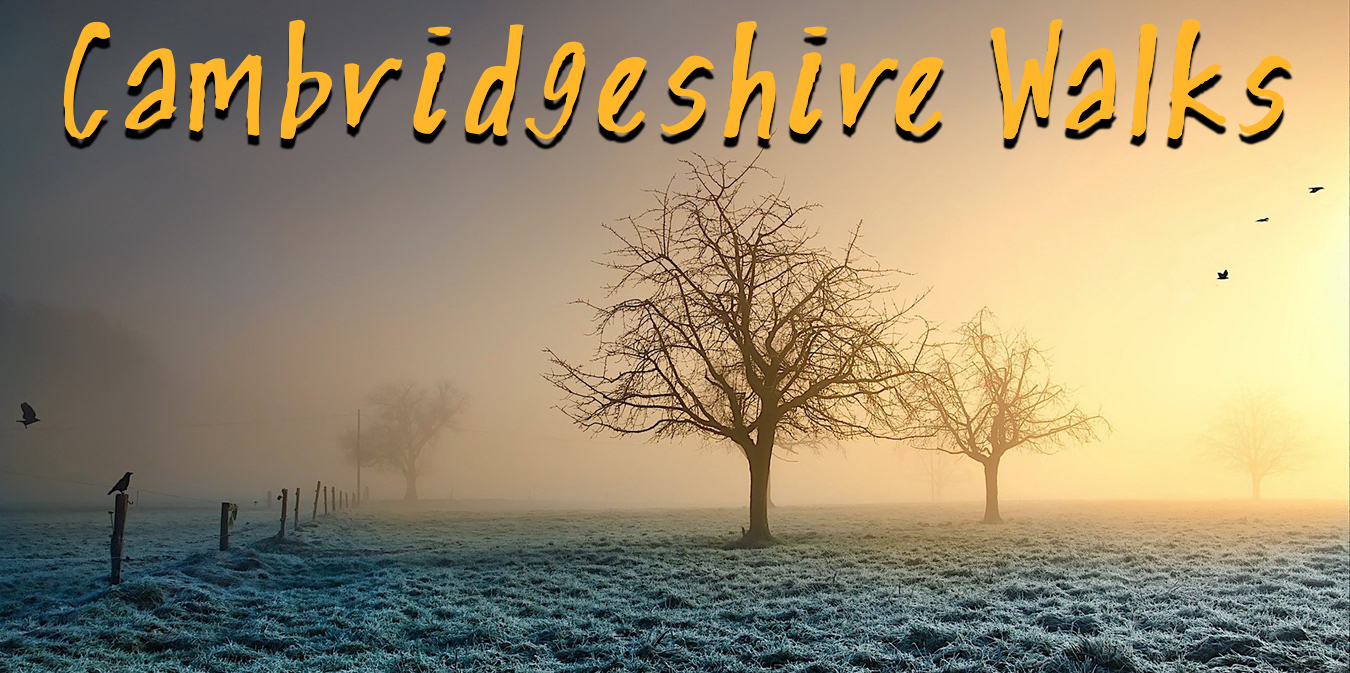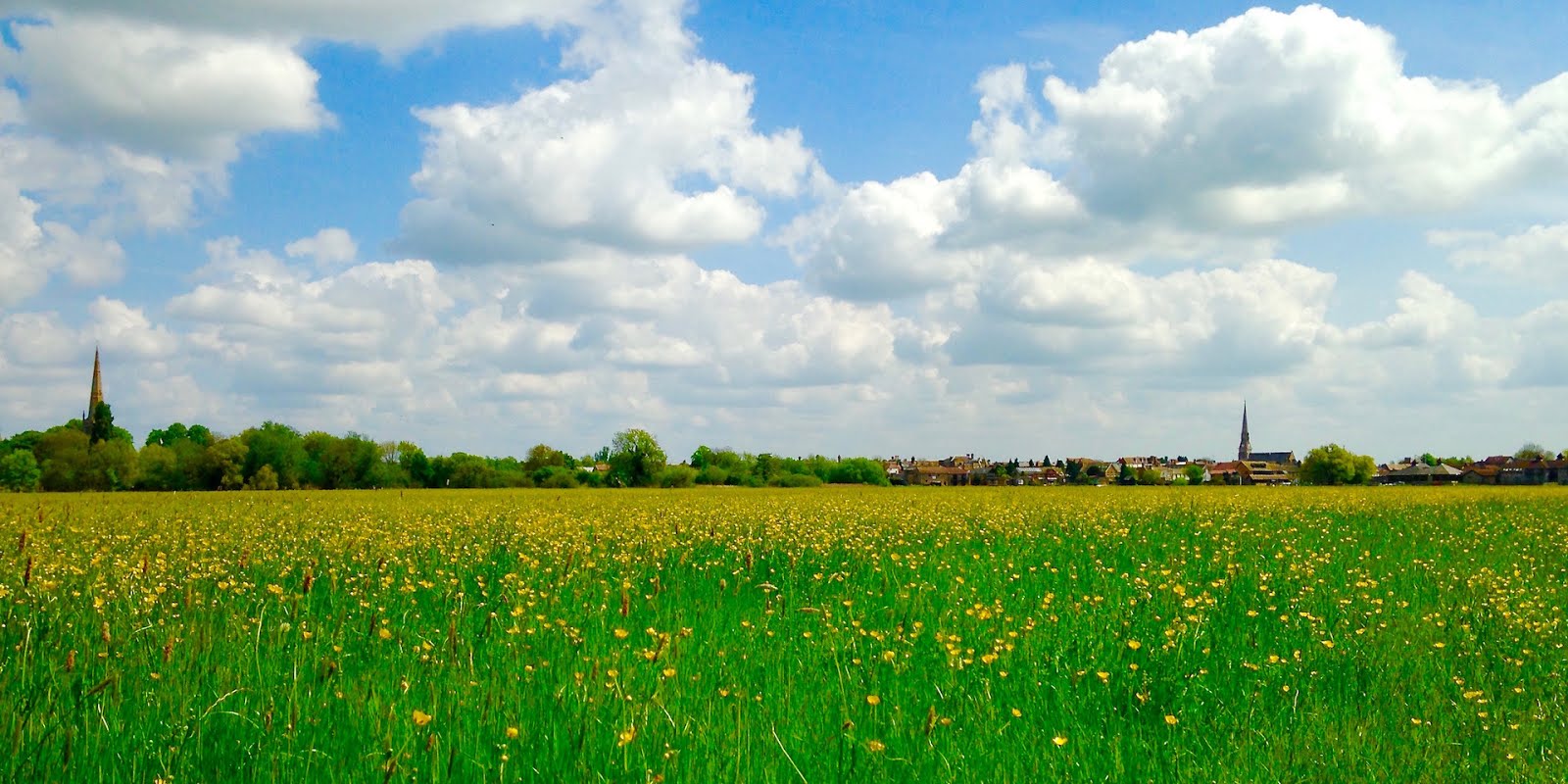This walk is a real stress-buster. Perfect for a sunny weekday evening, in under an hour you'll view one of the best wildflower meadows around. Walk along hedges full of moths and butterflies sipping the nectar from blackberry blossom. Watch swallows jetting the meadow, catching insects on the wing. Amble along riverside bursting with fish and bird life. As you approach the end, there's no better view of our beautiful St Ives.
Historian Bridget Smith, in her talk to the Civic Society of St Ives in 1997, regretted the loss of the meadow's wildflowers through agricultural spraying. The County Stewardship Scheme was paying farmers not to use sprays, and she hoped the meadow would recover its former floral glory in 50 years time. View the meadow today from St Ives bridge in May and you'll get a hint how quickly that recovery is taking place. The meadow is filled with millions of golden buttercup flowers, quickly followed by purple clover. But since they're facing away from the bridge and towards the sun, to get the full impact you just have to walk the meadow.

This 2 miles (4,400 steps) walk takes you through an ancient meadow along hedgerows and riverside. Beautiful open aspect. In spring and summer the meadow is resplendent with the blooms of buttercups, clover and other wild flowers, the hedges full of insects. Food and snacks available. Wildlife and historic interest. Can be very muddy in winter, impassible if the Great Ouse is in flood. The route is shown below on the Ordnance Survey map. You can also zoom in on a satellite view of the walk at Google Maps.
Historian Bridget Smith, in her talk to the Civic Society of St Ives in 1997, regretted the loss of the meadow's wildflowers through agricultural spraying. The County Stewardship Scheme was paying farmers not to use sprays, and she hoped the meadow would recover its former floral glory in 50 years time. View the meadow today from St Ives bridge in May and you'll get a hint how quickly that recovery is taking place. The meadow is filled with millions of golden buttercup flowers, quickly followed by purple clover. But since they're facing away from the bridge and towards the sun, to get the full impact you just have to walk the meadow.

This 2 miles (4,400 steps) walk takes you through an ancient meadow along hedgerows and riverside. Beautiful open aspect. In spring and summer the meadow is resplendent with the blooms of buttercups, clover and other wild flowers, the hedges full of insects. Food and snacks available. Wildlife and historic interest. Can be very muddy in winter, impassible if the Great Ouse is in flood. The route is shown below on the Ordnance Survey map. You can also zoom in on a satellite view of the walk at Google Maps.
Starting point
Walk over St Ives bridge and past the entrance to The Dolphin Hotel. Follow the footpath sign off to the right which takes you across the entrance to the hotel car park.
Look back across the car park to the New Bridges causeway heading south away from St Ives bridge. There has been a causeway across the boggy flood meadow to the bridge for at least 700 years, originally an earth bank with a series of smaller bridges over streams. The current New Bridges is a magnificent structure, the longest road causeway with continuous arches in the country. Consisting of 55 arches and about 1,300,000 bricks made in St Ives, John Turner took just 23 weeks to completion in 1822.
Walk under an arch, part of the hotel's accommodation, to a stile giving access to the meadow. Just before passing through the stile look for agile swallows jetting close. Particularly in late summer, they patrol the inlet and stream catching insects on the wing.
Look back across the car park to the New Bridges causeway heading south away from St Ives bridge. There has been a causeway across the boggy flood meadow to the bridge for at least 700 years, originally an earth bank with a series of smaller bridges over streams. The current New Bridges is a magnificent structure, the longest road causeway with continuous arches in the country. Consisting of 55 arches and about 1,300,000 bricks made in St Ives, John Turner took just 23 weeks to completion in 1822.
Walk under an arch, part of the hotel's accommodation, to a stile giving access to the meadow. Just before passing through the stile look for agile swallows jetting close. Particularly in late summer, they patrol the inlet and stream catching insects on the wing.
There's an information board at the meadow entrance. Although you can walk more directly across the meadow, the best route is to turn left and follow the path, keeping the stream on your left.
Point 1
After 160 yards the route turns right. For almost half the walk you'll be ambling along hedging full of blackberry blossom and fruit, with varieties of moths and butterflies feeding on nectar.
Point 2
About halfway along the path you may have noticed occasional white posts along the edge of the meadow. Look across to the opposite side and you'll see similar posts. These mark the boundaries of meadow land for owners. Sheep graze freely across the meadow, owners generally leasing their allocation of grazing to local farmers.
The meadow dates from before the Domesday Book of 1086. The bank on the south side is probably 13th century in origin. Each winter the meadow is enriched by silt as the River Great Ouse floods across the whole area. After severe frost the flooded meadow becomes the biggest ice skating rink in the country.
Point 3
Another right turn and you're walking along the southern bank of the River Great Ouse, full of wild flowers and grasses. Reeds and lilies line the riverside. Notice the colour of foliage in the trees on the opposite bank in The Thicket, pale yellow, bright orange, acid greens and dark copper.
The river is bursting with wildlife. Graceful terns patrol, darting down to scoop a minnow out of the water. In breeding season you'll see nesting mute swans opposite. A great crested grebe may float by with young nestled on its back. Stationary grey herons await a meal along the river bank. A reptilian cormorant may be standing guard at the top of a willow tree.
There are so many fish in the river, constant ripples break the surface as they rise for insects. About 350 yards along the river bank there's a small sandy beach for children to paddle. Approach carefully and you'll see dozens of small fish enjoying the warm shallows. The air is filled with the song of skylarks, the meadow full of grasshoppers.


Point 4
On the opposite bank you'll pass Noble's Field and then Ingle Holt Island. As you approach the end of the riverside section of the route there are stunning views of St Ives bridge and the river. On Sunday mornings and evenings members of St Ives Rowing Club skull along the river.
Follow the footpath along the river bank until it turns right to return to the inlet by The Dolphin Hotel. A few more yards and you return to the stile into the meadow.
Looking for somewhere to snack? Just over the bridge is the River Terrace, with a lovely terrace area overlooking the river. Further up Bridge Street is The Taproom, also recommended. Amore has tables along the Quay for Italian coffee and food.
Click the 'Print Friendly' button below to print out this walk to take with you. Or of more walks click the 'Return Home' button at the foot of this page. Did you enjoy the walk? Notice anything unusual? Why not add a comment below to tell fellow amblers what you liked about it?
Click the 'Print Friendly' button below to print out this walk to take with you. Or of more walks click the 'Return Home' button at the foot of this page. Did you enjoy the walk? Notice anything unusual? Why not add a comment below to tell fellow amblers what you liked about it?





Did my own meadow walk in February of 2009 for my birthday (I was an American tourist). It was a delight. A swan followed me the length of the meadow, despite the fact that I had nothing for him or her to eat. I encourage anyone within the sound of this post to tour this lovely lovely meadow!
ReplyDeleteReally appreciate the positive feedback. Thank you! Hope you get the chance to revisit our beautiful little town. John
DeleteDid this lovely walk today and as well as the highlights mentioned we were thrilled to see a seal basking and fishing in the middle of the river!
ReplyDeleteHurrah! Stan the St Ives seal is back again. Last seen just before last floods. Appreciate the update. on Hemingford Meadow
DeleteAs an exiled St Ivian, I never think of the meadows as a 'tourist walk', although it is a good one! It was my playground from 60 years ago. Picnics and school walks as a child, endless summers, fishing every day. Joining the Rowing Club, out every evening, and regattas at weekends, building up to the St Ives Regatta from Noble's Field in August. The setting for teenage romances and the venue for my wedding in more recent years. St Ives has changed a great deal over the years but it was the setting for the first 20 years of my life and to say that I have a soft spot for it would be an understatement!
ReplyDeleteThat's a lovely comment, Richard. And a good reminder of how important the meadow is to St Ives and its residents. Without it our town would be just another typical shape, but because of limitations the meadow imposes on development, we have beautiful vistas all over the town centre. Really appreciate the feedback. John
Delete